
Looking Sharp, Mr Moon
OK, I’m not sure if the Moon has a gender, but work with me here, please. In September, I bought myself a telescope, and a few days back, I used it to photograph the Moon. My favourite style of night-sky photo is still a “nightscape” image, which includes a landscape feature as well as something to marvel at in the sky. The type of ‘scope I bought–known as a Dobsonian, or “Dob”–isn’t the best kind for taking photos with, but I couldn’t resist seeing what I could get out of it.
The Moon was at 95% of its full phase when I captured it from my home in Sydney, Australia, on Thursday, October 29. It would have been better to photograph it earlier in its current cycle, but Thursday night was the only chance I’d had for weeks on end.
As mentioned above, to create this photo I used my new Sky-Watcher 8” Goto collapsible telescope, to which I attached my Canon EOS 6D Mk II camera. I shot 58 frames and used 20 of those, stacked in Registax, to enhance the amount of detail visible.

Stark
The Moon was at 92% of its full illumination as I photographed it setting over Tuross Lake, on the New South Wales south coast last Friday morning, July 3rd.
I had to close the lens’ iris down to a small opening so that the Moon’s brightness didn’t overwhelm the photo and blot out the details of the seas (“mare”) and craters on our heavenly neighbour’s surface. The resulting starkness of the shot hooked me when I saw it on my computer’s screen. I hope that my photo captivates you, too!
The shot is a single-frame image, captured with my Canon EOS 6D Mk II camera, attached to a Sigma 50-500mm f/5.6 lens @ 313 mm and set to an aperture of f/9.0, using an exposure time of 1/30 seconds @ ISO 400.
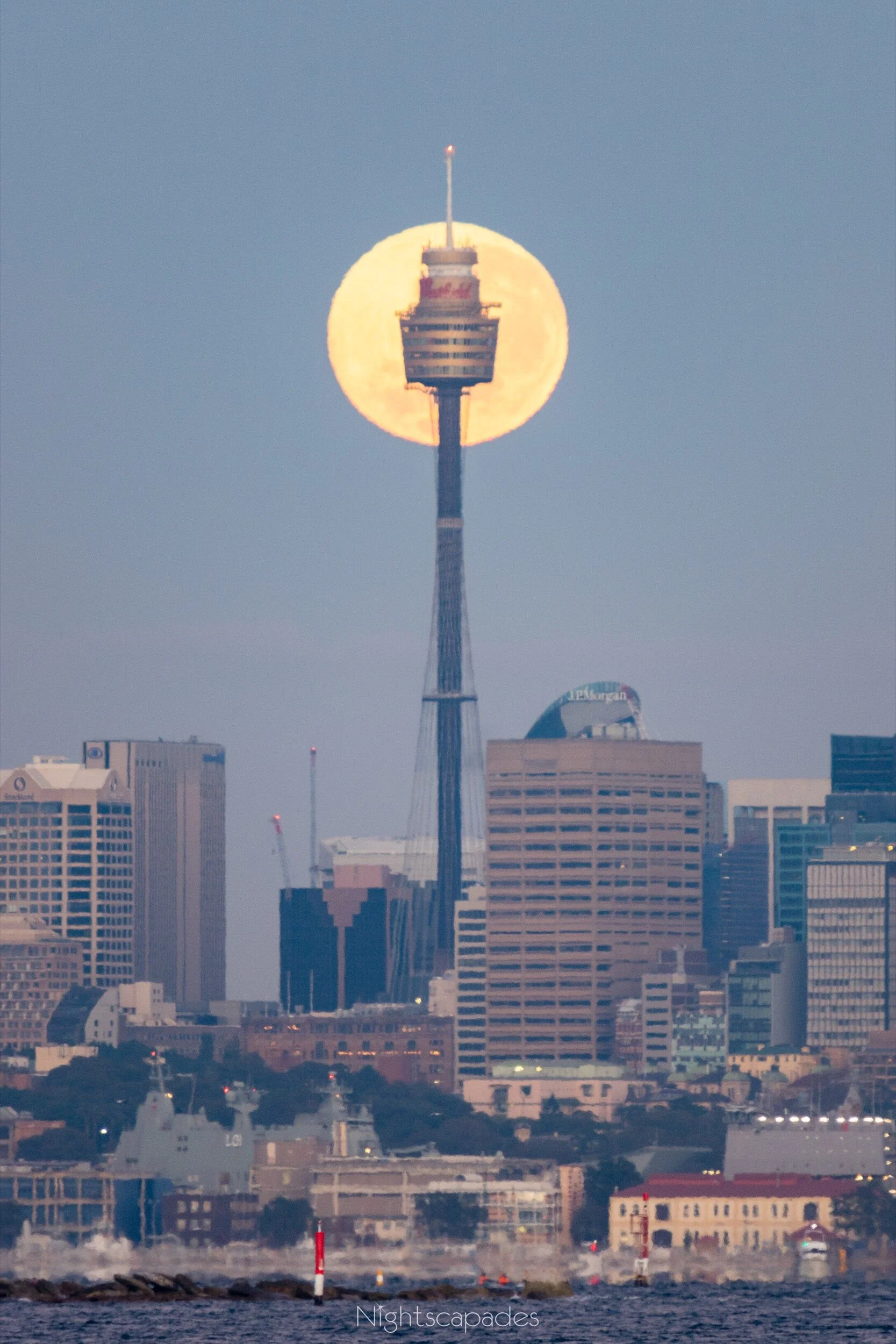
Centred
This morning (Sat 6th June) there was a penumbral lunar eclipse visible in Eastern Australia. Well, visible is a stretch, since the dimming of the Moon's light during a penumbral eclipse is nigh on impossible to see.
Still, with almost every lunar eclipse visible from Sydney in the last six years having been clouded out, waking up to find that the forecast clear skies were a reality was motivation to get out of my warm bed and set off for a shoot.
By the time the Moon was in a position for me to create this shot, the eclipse was all but over and there’s no visible sign of it in the photo. My image shows the full moon as it was dipping to the western horizon, behind the Sydney Tower Eye (aka Centrepoint Tower), which was 7.5 km from my spot on the beach at Watsons Bay.
Shot with my Canon EOS 6D Mk II camera and a Sigma 50-500mm f/5.6 lens @ 500mm @ f/7.1, using an exposure time of 1/25 sec @ ISO 400.

White and Crimson and Blue
Once again this morning, I was treated to a beautiful sight from my balcony as the 25%-illuminated Moon was adorned by some high clouds, made crimson by the pre-sunrise light refracting around the Earth’s atmosphere. The purity of the white light coming from the moon’s surface always looks enchanting to me and having the colours of the background sky and sunlit clouds added to the joy of it all this morning.
I captured this scene with my Canon EOS 6D Mk II camera, a Sigma 50-500mm f/5.6 lens @ 500mm focal length and set to an aperture of f/8.0, using an exposure time of 1/100th of a second @ ISO 800.

Launceston Lunar Light Tower
Taken in January of 2020, my photo captured the Moon sliding towards the western horizon in Launceston, in the Australian state of Tasmania. There was a penumbral lunar eclipse at this time (11th January Australian Eastern Daylight Time), but it's hard to see any dimming of the Moon's light in this image.
A penumbral eclipse occurs when the Moon's orbit takes it through the outer shadow of the Earth, which is less intense and less distinct than the central shadow, or "umbra". Not being familiar with the city and its landmarks due only being in Launceston for two nights, I found it challenging to locate a suitable structure to silhouette against the Moon's glow. The best I could do was this lighting tower at the University of Tasmania Stadium.
Another single-frame image, this photo was shot with my Canon EOS 6D Mk II camera, a Sigma 50-500 mm f/5.6 lens @ 500 mm @ f/6.3, using an exposure time of 1/50 second @ ISO 400.

Five moons
I snapped this image of Jupiter, flanked by its four "Galilean" moons–Ganymede, Europa, Io & Callisto–in conjunction with the Earth's waning-crescent Moon in the skies over Australia last Thursday, 20th of February. Looking carefully, you can see details in the darker portion of the moon. The moon here is lit with what is called "earthshine", which is light from the sun, bouncing off the Earth, lighting up the moon, then bouncing back to Earth for us to see.
Shot with my Canon EOS 6D Mk II camera, a Sigma 50-500mm f/5.6 lens @ 500mm @ f/8.0, using an exposure time of 0.3 seconds @ ISO 800.

Hope Through the Smoke
For a few weeks now, my city of Sydney, Australia, has been affected by smoke from bushfires burning on the city’s outskirts, and beyond. The daily cycle has become that of a deep red sunrise, followed by hours of yellowed skies, brought to a close by a setting sun that is even redder than when it began the morning. On a typical day, the Moon only takes on an orange hue when close the horizon, beaming with a distinctive white glow for the majority of its hours overhead. For many on Australia’s eastern coast, though, we now see an orange-red moon while ever the rocky satellite is visible in the night sky.
Tonight (5th December), I took a short drive and did my best to shoot some photos that showed off this smoke-stained visage of Earth’s nearest neighbour. Wanting to capture images that weren’t merely the orange Moon against the hazy sky, I spent time looking for something to bring some perspective, and hope, to the scene. These lights on the Christmas tree at the St Andrews Anglican Church at Cronulla were happy to emit their lively colours to brighten the eerie night.
For this single-frame photograph, I used my Canon EOS 6D Mk II camera, a Sigma 50-500mm f/5.6 lens @ 500 mm @ f/16, using an exposure time of 1/100 of a second @ ISO 6400.

Proximity
The lengthy driving trips that I take to photograph the stars in rural locations are always enjoyable. They give me a lot of time to listen to podcasts, audiobooks or (rarely) some music. I’m not one to turn down a quick trip, though, so having to drive only ten minutes from home to get this photo at Sandringham, Australia, was just as pleasant.While not as awe-inspiring as the total eclipse of July last year, July 2019’s partial lunar eclipse was still very photo-worthy. The event began before sunrise but didn’t reach its maximum until after the moon had set. I captured this shot fifteen minutes before the moon sank behind the bridge and the suburbs beyond. If you look closely, you can see a jet on its approach to Sydney International Airport, bringing in another morning load of travellers.This image is a single-exposure photo that I shot with my Canon EOS 6D camera, fitted with a Tamron 70-300 mm lens zoomed to 209 mm. I set the aperture to f/8.0, the shutter speed to 1/10 sec and the ISO setting was 200.

Mercury and the Moon and the Morning Light
With the Moon only two days from ending its current cycle, its visible sunlit surface is now a thin crescent, or as I used to call it when I was a child, a fingernail cutting. The soft and subtle glow on the Moon’s earth-facing side–an illumination that astronomers call “earthshine”–was dimmed somewhat by the thin clouds that were heading towards the east as I shot this photo this morning, Sunday 22nd of March, 2020.
The Sun was hiding below the horizon, but its reddened beams were bright enough to give a crimson hue to those same high and thin clouds. In the thickest section of cloud here in the photo, I caught a pinprick of light from the planet Mercury, our Sun’s nearest neighbour in space. You will probably need to zoom in to see the little yellowish dot. What a lovely sight these two celestial characters provided for the beginning of my Sunday!
This photo is a single-frame image that I captured with my Canon EOS 6D Mk II camera, through a Tamron 70-300 mm lens @ 259 mm and with its aperture set to f/5.6, using an exposure time of 1/10 second @ ISO 800.
Iconic tower. Magic Moon
A waxing gibbous moon hanging in the dark sky with the Eiffel Tower glowing in the foreground. I shot this photo in December of 2015, while visiting Paris to see one of my photos featured in an exhibition.
Canon EOS 6D camera, a Sigma 50-500mm f/5.6 lens @ 191mm @ f/10.0, using an exposure time of 1/13 seconds @ ISO 200.
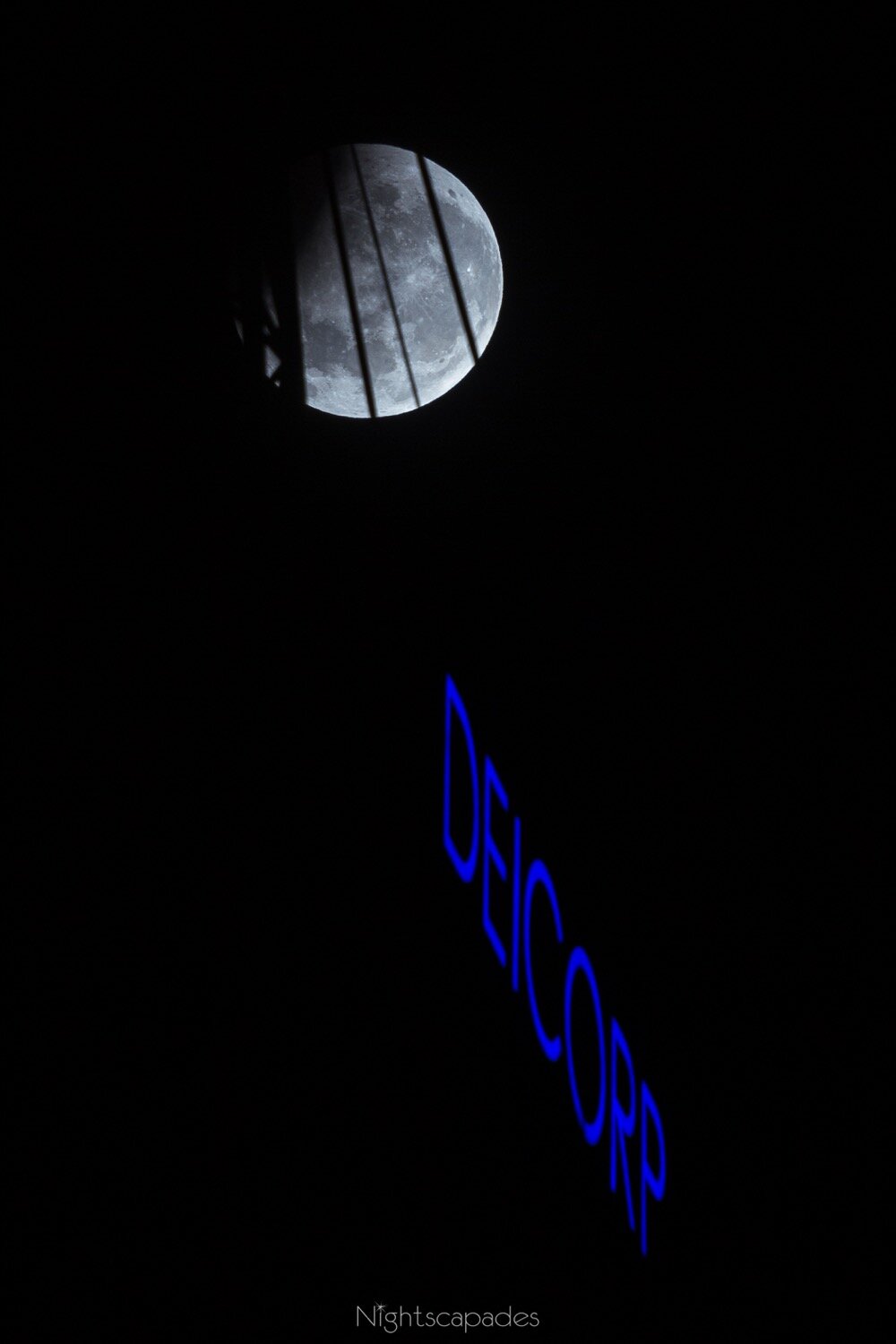
A bite out of the moon
This photo of the moon and a construction crane was taken in August of 2017, at close to 4:40 am. Fortunately, the location was only a five minute drive to from my home. You can’t see much of the crane here but I did manage to use the moon to silhouette some of the crane’s structure and also get the construction company’s logo.
I shot the photo with a Canon EOS 6D, Sigma 50-500mm lens @ f/16, 1/50 sec @ ISO 400.
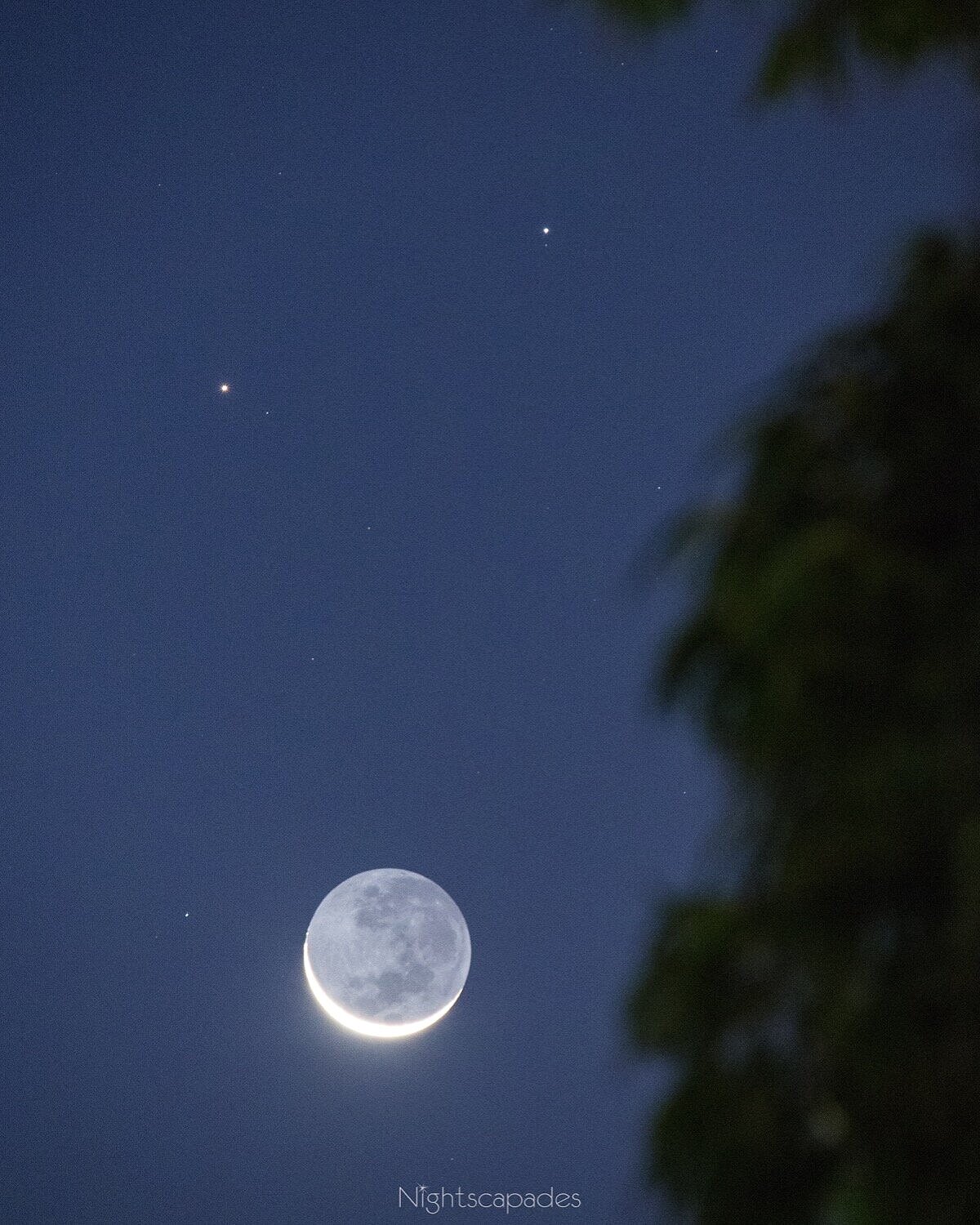
The Moon and Mercury
I took this photo from the balcony of my apartment in suburban Sydney, Australia, in 2017. Mercury is the bright star-like dot to the upper left of the moon in my photo.
Up and to the right of Mercury is the star Regulus, the brightest in the constellation of Leo. Well, I say "star" but Regulus is actually a quaternary system, that is it's actually four stars rather than just one.
Captured with Canon EOS 6D, Sigma 50-500mm lens @ 417mm @ f/8.0, 1.0 sec @ ISO 6400.

The Red Orb
On the eastern coast of Australia we missed out on seeing the July 2018 total lunar eclipse all the way through. The point of maximum eclipse was reached at 6:21 am, and the Moon then set at 6:55 am. Although I took lots of photos that featured Mars as well as the Moon, I’m particularly taken with this one showing the fully-eclipsed moon on its way to setting behind Seven Mile Beach, Australia. It's going to be nearly three years before the next total eclipse that's visible from my part of the world.
Canon EOS 6D, Sigma 50-500mm lens @ 161mm @ f/5.6, 1.0 sec @ ISO 3200.

Blood orange
In the same way that the bending (refracting) of light at sunrise and sunset gives the sky a red colour, sunlight refracted by the Earth’s atmosphere tints the Moon with this copper-coloured visage during a lunar eclipse’s “totality” phase.
Shots like this of the orange-red moon against a black sky are probably the most common type of photo I’ve seen of total lunar eclipse events. My preference is to capture images that include a terrestrial scene in them as well as the moon. Still, I find something engaging and intriguing about these moon-and-sky shots, and so chose to include this one of the total lunar eclipse of July, 2018.
Captured with a Canon EOS 6D, Sigma 50-500mm lens @ 500mm @ f/6.3 with a 0.8-second exposure @ ISO 3200.
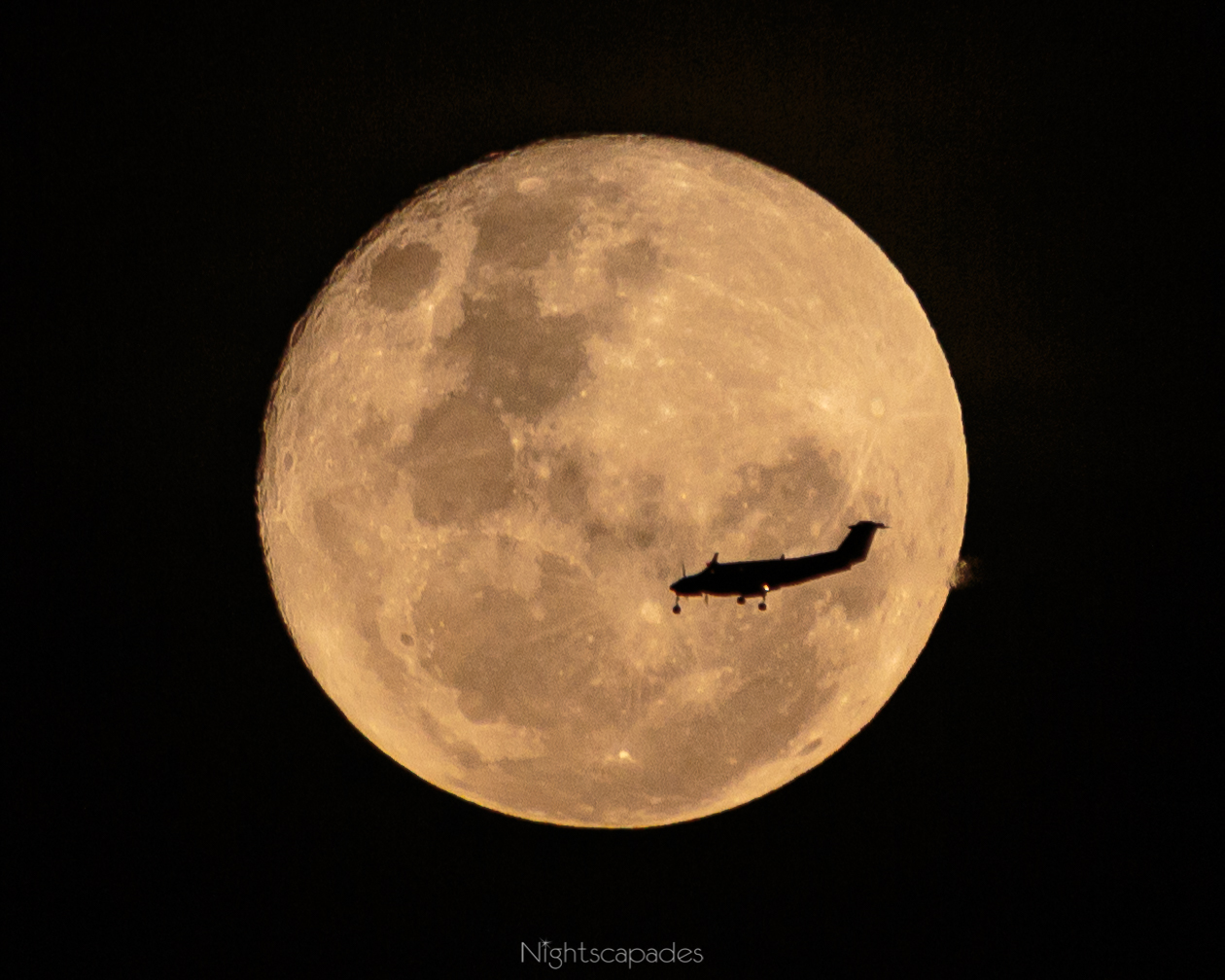
Ambulance on approach
Shot one day after its full phase, here is the 99% full Nov 2016 "supermoon" providing a backdrop for a Beech B300 Super King Air on approach to Sydney’s Kingsford Smith International Airport (Australia).
This aircraft is operated by the The Royal Flying Doctor Service of Australia (RFDS), one of the largest and most comprehensive aeromedical organisations in the world.
Perhaps one day their area of service will include the moon! Shot with Canon EOS 6D, Sigma 50-500mm lens @ 500mm @ f/7.1, 1/500 sec @ ISO 800.
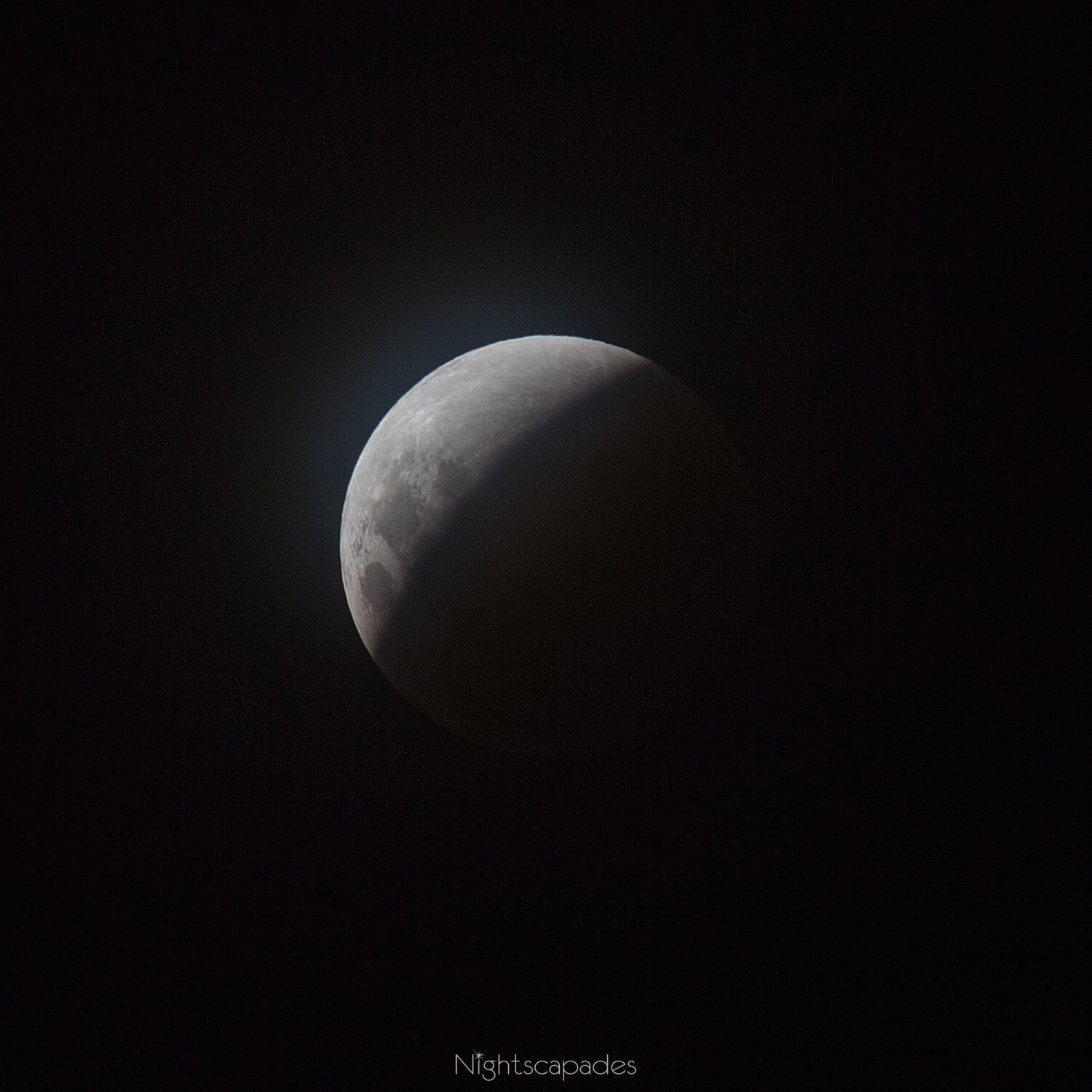
Eclipse. "To obscure or block out"
Apart from a few brief exceptions, this title describes my experience of the total lunar eclipse of late-January, 2018. The eclipse of the moon was itself eclipsed/obscured/blocked out by clouds that covered the sky from just before the eclipse started until I got home at 2:30 the next morning.
In case you’re wondering, yes, I did try hard to find some cloudless locations. How hard? 685km of driving (426mi), multiple stops to check the situation and update the weather satellite feed on my iPad. 10.5 hours from leaving home to returning and getting into bed. Better luck next time, perhaps?
A focus-stack of five shots, captured with Canon EOS 6D, Sigma 50-500mm lens @ 500mm @ f/10.0, 1/60 sec @ ISO 800.

Looking Sharp, Mr Moon
OK, I’m not sure if the Moon has a gender, but work with me here, please. In September, I bought myself a telescope, and a few days back, I used it to photograph the Moon. My favourite style of night-sky photo is still a “nightscape” image, which includes a landscape feature as well as something to marvel at in the sky. The type of ‘scope I bought–known as a Dobsonian, or “Dob”–isn’t the best kind for taking photos with, but I couldn’t resist seeing what I could get out of it.
The Moon was at 95% of its full phase when I captured it from my home in Sydney, Australia, on Thursday, October 29. It would have been better to photograph it earlier in its current cycle, but Thursday night was the only chance I’d had for weeks on end.
As mentioned above, to create this photo I used my new Sky-Watcher 8” Goto collapsible telescope, to which I attached my Canon EOS 6D Mk II camera. I shot 58 frames and used 20 of those, stacked in Registax, to enhance the amount of detail visible.

Skydance
I’ve been keeping watch on the lovely celestial show in the western sky after sunset in the closing days of November. After commencing a new cycle on the 26th of the month, the Moon has been dancing its way through the gathering of naked-eye planets in that part of the heavens. On this night–28th November–I photographed the Moon when it was only 1% illuminated and a mere sliver of light pushing through the haze of bushfire smoke that marked the sky near Nerriga, Australia.
The pinprick of light that you can see above and to the left of the Moon denotes the position of Jupiter, our Solar System’s most massive planet and also the second-largest source of gravitational disturbance in our planetary nuclear family. High above, its light at once diffused and brightened by the endemic smoke and cloud, the planet Venus unmistakably telegraphs its location to those on the lookout for such wonders.
To quote the late Leonard Nimoy from his role in “The Simpsons”, Season 4/Episode 12, “The cosmic ballet goes on”.
For this single-frame photo, I used my Canon EOS 6D Mk II camera, a Tamron 70-300mm lens @ 200 mm @ f/5.0 using an exposure time of 6.0 seconds @ ISO 1600.

















